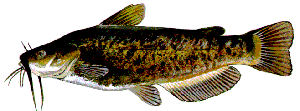
Bull Head
Characteristics - olive to brown with dark mottlings on sides, fading to white or cream underneath; fleshy barbels dusty to black; 22-23 rays in anal fin; caudal fin slightly notched.
Distribution - rivers in the southern portions of the province.
Foods - crayfish, aquatic invertebrates, other fish.
Other names -- bullhead, brown bullhead, mud puppies.
The brown bullhead is widely distributed in the southern part of the province, where it is common. Most major tributaries of the larger southern lakes hold stable populations. These fish are "fodder" for many other species in theses southern waters. eg. Walleye do key on them at certain times of the year in particular Manitoba watersheds. The brown bullhead is taken most commonly in the Red, Assiniboine, Whitemud and Winnipeg rivers.
The color of the brown bullhead is olive to brown with dark mottlings on the sides, fading to white or cream beneath. Fleshy barbels are dusky to black. It can be readily distinguished from the black bullhead by the lack of a light-colored bar at the base of the tail fin and black coloration in the membrane between the rays of these fins. There are numerous strong barbs that form a serrated back side of the pectoral fin spines. There are from 20 to 24, usually 22 or 23, rays in the anal fin. The caudal fin is slightly notched.
Brown bullhead spawn rather early in the spring, usually in late April or May. Male fish fan out a saucer-shaped nest in the mud or nests in natural cavities where the female deposits eggs. The number of eggs will range from 2,000 to 10,000, or more. The eggs are guarded by both parents during the incubation period, which is usually 5 to 8 days. After the eggs hatch, they are herded about in schools for several weeks. At the end of their first year of life they reach a length of about 2 1/2 to 4 inches and mature in five years. They grow to about 2 pounds under ideal conditions, although most specimens will average from about 8 to 10 inches and weigh less than a pound.
The brown bullhead lives largely upon insect larvae, crustaceans, snails, small crayfish, worms, and small fish. Like all bullheads, it is tenacious in life and will feed eagerly on nearly anything available, either living or dead. The fish travel in schools and feed on or near the bottom. A large part of their diet consists of midge fly larvae, called bloodworms because of their red color, which they pick up from the soft bottom ooze. Considerable plant material is commonly found in stomachs, but it is believed that this material is taken incidentally while feeding on insect larvae living in the plants. The teeth are in pads on both jaws and are used largely for tearing and pulling off pieces of their food. Brown bullheads have ravenous appetites and seem to be hungry at all times of the day and night.
Manitoba's premier Bullhead fisheries can be found in small rivers and creeks which hook up to lake Manitoba. Still fishing with minnows or worms in the fall and spring of the year will yield excellent fish.